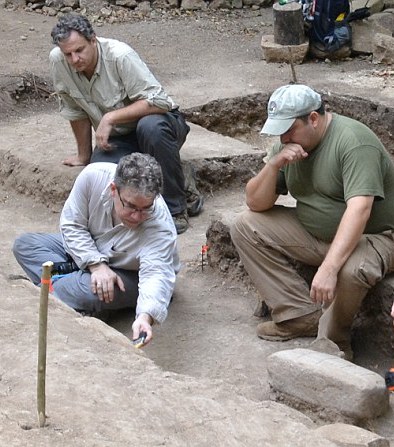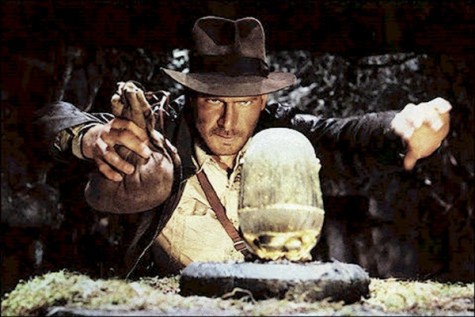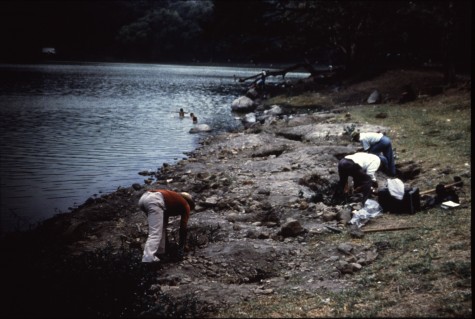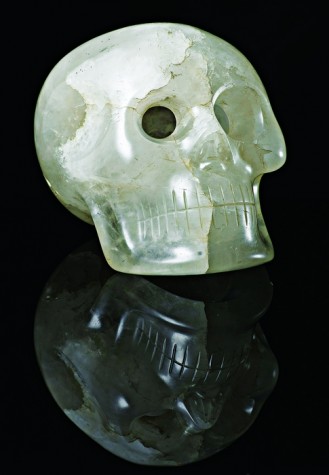The jungles of the Peten are hot and sweaty. Most of the best places for archeology are. Field seasons are especially hot, since they are always during the driest time of year so that the site doesn’t get flooded. Howler monkeys boom from the parched trees, which barely twitch during the windless days. Meanwhile, pasty grad students toil away in the hot sun, quietly picking away at a stucco relief or the markings on a stone pillar.
In this heat, it’s good to wear a hat, preferably something sturdy with a wide brim. Every archeology site in the world is littered with rugged people in wide-brimmed hats talking about long dead civilizations. Tulane archeologist Marcello Canuto, for instance, prefers the khaki, floppy variety. Walking back to camp with after a long day at one Northern Guatemalan site, I can’t help but make the obvious comparison.
“Oh God,” he groans, “Don’t even go there. Indiana Jones is not an archeologist.”
It’s not surprising that academics – hell bent on taking the fun out of everything – would hate our beloved and iconic movie version of them. But Canuto is no killjoy. His ironic tone and acerbic wit seem honed by long boring days in the sun. So I bite. I quickly learn that there’s a good reason why most every archeologist on Earth hates Indy. And that they might have a point. Because Jones isn’t an archeologist at all.
“That first scene, where he’s in the temple and he’s replacing that statue with a bag of sand – that’s what looters do,” Canuto says, grinning. “[The temple builders] are using these amazing mechanisms of engineering and all he wants to do is steal the stupid gold statue.”
 Think about it. Here’s Indy, in some ancient tropical temple whose booby traps have miraculously not turned to dust with age and humidity. All the ropes, wooden blocks, gears, whatever – they still function. This is a treasure trove of information for an archeologist. How did their technology work? How did they get that giant rock to the top of that ramp? What powered their poison darts?
Think about it. Here’s Indy, in some ancient tropical temple whose booby traps have miraculously not turned to dust with age and humidity. All the ropes, wooden blocks, gears, whatever – they still function. This is a treasure trove of information for an archeologist. How did their technology work? How did they get that giant rock to the top of that ramp? What powered their poison darts?
But no, he goes for the least interesting but most economically valuable thing in the temple – a golden statue. A real archeologist would have taken a photo of it, told the Nazis they could have the stupid thing, and spent the next 10 years studying the temple’s booby traps.
Or what about the part where he slips into a dig site in Egypt and tries to steal the Ark of the Covenant?
“True, the Nazis were trying to find the Ark of the Covenant so they could destroy the world,” Canuto says. “But methodologically and legally they were in the right.”
Whatever you may think of evil archeologists bent on world domination, they presumably had permits to be there. And while the early days of Egyptian archeology were corrupt and exploitative, it was far better than just allowing foreign looters to run wild. Looters like Indiana Jones.
“If someone was to come into my camp and dig up the site with some knowledge I didn’t have, and I was to catch them in the middle of the night, yeah, I might throw him in a snake pit too,” Canuto laughs.

Archeology is rife with tales of looters and researchers clashing over stolen artifacts whose proliferation is among the largest illegal markets in the world (behind, but often connected to, drugs and guns). People don’t talk much about it, but antiquity looting is a major source of cash for global criminals.
I know what you are going to say – Indy was just trying to put things in museums. When exactly did he ever actually succeed? And whose museums? Certainly not those of the countries where he was looting. He never documents or publishes his finds – meanwhile his collaborators are mostly monkeys and showgirls. In fact, we now know that Indy’s style of looting actually damages our understanding of culture and robs us of our history.

Last month I wrote a story for National Geographic about the history of looting in the Maya region that barely scratches the surface of the problem. The real life Indiana Joneses of the world are not wise-cracking professors with bullwhips. They are poor farmers and hooligans pushed by desperation and warfare to the fringes of society where they eke out an existence, destroying our only opportunities to understand ancient cultures.
Just like Indy, most looters are so consumed with getting something they can sell, they destroy the parts of a site that might actually inform scientists. Temples become craters in the ground and bones containing crucial genetic information are chucked aside. But worst of all, we lose the context of the artifact – where it was found and what that might mean. And just like Indy, they are happy to shoot anyone who gets in their way.
All of this, just so a wealthy foreign collector can put a stone panel on his wall or have a cool bowl to hold his keys at night.
“Their point of view is that it is my right to destroy your country, your past, to decorate my house,” says Karen Olsen Bruhns, an archaeologist at San Francisco State University.

In this way – and please don’t hate me for saying it – Lara Croft is more honest than Indiana Jones. She doesn’t pretend to be an academic or make speeches about what belongs in a museum. She’s a wealthy, corrupt tomb raider and she doesn’t hide it.
This is not to say all collectors are bad – most are just ignorant of what was destroyed or who was killed to get their precious knick knack. A few I talk to for the story are genuinely trying to atone. But it still seems a silly reason to rob a people of their history.
Thankfully, Central American looting today is on the decline and, as Bruhns points out with delicious irony, most available Maya artifacts are fakes (including Jones’s crystal skulls). But looting in other places, like the conflict-ridden Middle East and North Africa is exploding.
Meanwhile, rumor has it, a fifth Indiana Jones movie is now in the works. Keep in mind that the last one was so bad, it coined a new phrase just to describe similarly awful movies.
In the end, despite being a terrible archeologist, Indiana Jones still holds a special place in the hearts of people like Canuto. He was twelve when he saw Raiders of the Lost Ark and discovered an enduring love of exotic adventure and wide-brimmed hats. And like most of us, he can overlook a few criminal acts as long as the movies are still good. Which, frankly, is why Jones might want to think about hanging up his whip.
Photo Credits: Paul E. Amaroli, Marcello A. Canuto, and Paramount Pictures

52 thoughts on “Why Archeologists Hate Indiana Jones”
Comments are closed.